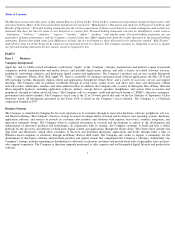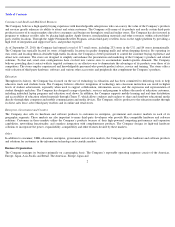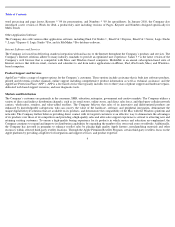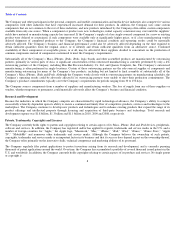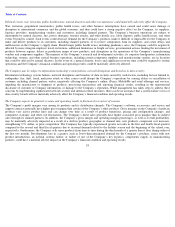Apple 2010 Annual Report Download - page 11
Download and view the complete annual report
Please find page 11 of the 2010 Apple annual report below. You can navigate through the pages in the report by either clicking on the pages listed below, or by using the keyword search tool below to find specific information within the annual report.
Table of Contents
The Company and other participants in the personal computer, and mobile communication and media device industries also compete for various
components with other industries that have experienced increased demand for their products. In addition, the Company uses some custom
components that are not common to the rest of these industries, and new products introduced by the Company often utilize custom components
available from only one source. When a component or product uses new technologies, initial capacity constraints may exist until the suppliers’
yields have matured or manufacturing capacity has increased. If the Company
’s supply of a key single-
sourced component for a new or existing
product were delayed or constrained, if such components were available only at significantly higher prices, or if a key manufacturing vendor
delayed shipments of completed products to the Company, the Company’
s financial condition and operating results could be materially
adversely affected. The Company’
s business and financial performance could also be adversely affected depending on the time required to
obtain sufficient quantities from the original source, or to identify and obtain sufficient quantities from an alternative source. Continued
availability of these components at acceptable prices, or at all, may be affected if those suppliers decided to concentrate on the production of
common components instead of components customized to meet the Company’s requirements.
Substantially all of the Company’
s Macs, iPhones, iPads, iPods, logic boards and other assembled products are manufactured by outsourcing
partners, primarily in various parts of Asia. A significant concentration of this outsourced manufacturing is currently performed by only a few
outsourcing partners of the Company, including Hon Hai Precision Industry Co. Ltd. and Quanta Computer, Inc. The Company’
s outsourced
manufacturing is often performed in single locations. Certain of these outsourcing partners are the sole-
sourced supplier of components and
manufacturing outsourcing for many of the Company’
s key products, including but not limited to final assembly of substantially all of the
Company’
s Macs, iPhones, iPads and iPods. Although the Company works closely with its outsourcing partners on manufacturing schedules, the
Company’
s operating results could be adversely affected if its outsourcing partners were unable to meet their production commitments. The
Company’s purchase commitments typically cover the Company’s requirements for periods ranging from 30 to 150 days.
The Company sources components from a number of suppliers and manufacturing vendors. The loss of supply from any of these suppliers or
vendors, whether temporary or permanent, could materially adversely affect the Company’s business and financial condition.
Research and Development
Because the industries in which the Company competes are characterized by rapid technological advances, the Company’
s ability to compete
successfully is heavily dependent upon its ability to ensure a continual and timely flow of competitive products, services and technologies to the
marketplace. The Company continues to develop new products and technologies and to enhance existing products that expand the range of its
product offerings and intellectual property through licensing and acquisition of third-
party business and technology. Total research and
development expense was $1.8 billion, $1.3 billion and $1.1 billion in 2010, 2009 and 2008, respectively.
Patents, Trademarks, Copyrights and Licenses
The Company currently holds rights to patents and copyrights relating to certain aspects of its Macs, iPhone, iPad and iPod devices, peripherals,
software and services. In addition, the Company has registered and/or has applied to register, trademarks and service marks in the U.S. and a
number of foreign countries for “Apple,” the Apple logo, “Macintosh,” “Mac,” “iPhone,” “iPad,” “iPod,” “iTunes,” “iTunes Store,” “
Apple
TV,” “MobileMe”
and numerous other trademarks and service marks. Although the Company believes the ownership of such patents,
copyrights, trademarks and service marks is an important factor in its business and that its success does depend in part on the ownership thereof,
the Company relies primarily on the innovative skills, technical competence and marketing abilities of its personnel.
The Company regularly files patent applications to protect inventions arising from its research and development, and is currently pursuing
thousands of patent applications around the world. Over time, the Company has accumulated a portfolio of several thousand issued patents in the
U.S. and worldwide. In addition, the Company currently holds copyrights relating to certain aspects of its products and services. No single patent
or copyright is
8




